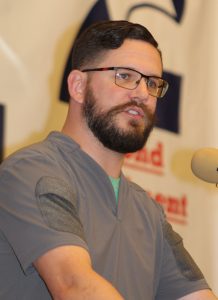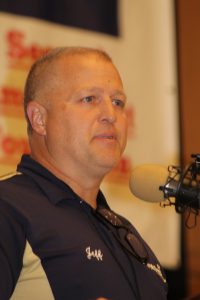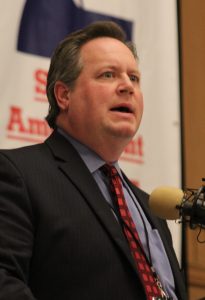By Dave Workman | Senior Editor
A refresher course on Second Amendment Doctrine, a discussion on suicide prevention with an expert from Washington State, and a report on current and possible future litigation were highlights of the 2019 Gun Rights Policy Conference in Phoenix.

Joseph Greenlee
Joseph Greenlee, director of research at the Firearms Policy Coalition, provided an in-depth rundown of current cases presently in the federal courts. The cases he discussed involved such things as carry, banning so-called “assault weapons” despite the fact that they are in common use, silencers/suppressors, rights restoration in Louisiana, and non-resident carry in Illinois.
There’s also a case in the Third Circuit Court of Appeals challenging a “high capacity” magazine ban in New Jersey.
Cases involve several states, including Illinois, Kansas, California and Massachusetts, as detailed by Greenlee. Some of these cases have been forwarded to the U.S. Supreme Court with requests for review. The high court does not take every case sent up from the lower courts, but there is some indication that the Supremes may be more agreeable to taking Second Amendment cases.
He was followed at the microphone by attorney and legal scholar David Kopel, research director at the Independence Institute. He discussed the history of gun rights, beginning with a recollection of gun control laws in Washington, D.C. and Chicago, where handguns were banned. He said both cities became dangerous with a “sudden and precipitous” increase in violent crime.

David Kopel
Kopel recalled also how police would search public housing to find firearms, but the searches were done without warrants and the courts hammered down on the practice.
Among the biggest effects of the McDonald and Heller rulings has been compliance with the constitutional right to keep and bear arms.
Another dramatic change, he said, has been the end of laws enacted in many states that had prohibited legal alien residents from owning firearms in their communities. He said everyone who has been involved in the Second Amendment movement “should be proud” of the advances that have been made in this rights arena.
Kopel said the question that the nation still faces is what new gun control measures will arise. He pointed to California, where anti-gunners have adopted new restrictions that are impossible to comply with, such as microstamping.
He closed with a brief look at the handgun law challenge in New York City, where officials actually changed the law in an effort to avoid a hearing before the U.S. Supreme Court. A hearing on that legal challenge is set for Dec. 2.
Suicide Prevention

Brett Bass
Washington State firearms instructor and Safer Homes project coordinator Brett Bass from Washington State provided a brief look at the progress being made in that state.
He told the audience that suicide prevention is a gun rights issue. He actually offered a workshop after the conference ended.
“Every time a person dies and a firearm is involved,” he cautioned, “that is ammunition used against us.”
In three instances in the past five years he has actually kept firearms belonging to someone else in a crisis situation.
A Marine Corps veteran, Bass said he personally went through some difficult times after leaving the service, so he’s keenly aware of the problems people face.
“We know from the data that the giant majority of firearms fatalities are not mass shootings or gang violence, it is overwhelmingly suicide,” he stated. “There is something we can do about it.”
Washington state has managed to reduce accidental firearms fatalities and he said the same thing can be done with suicide prevention.
Reversing School Disarmament

Jeff Staggs
Jeff Staggs, superintendent of Newcomerstown Schools in Ohio, led the discussion on reversing school disarmament, which translates to giving teachers the knowledge and skills to have firearms on campus to fight back against potential tragedies.
He said this is the 8th year for having an armed staff in his school district, and this came about after the Sandy Hook tragedy when he was approached by people in the district about school safety. He got involved in the FASTER Saves Lives program championed by the Buckeye Firearms Association. FASTER stands for Faculty, Administrator, Safety Training Emergency Response.
To date, he reported, the program has trained more than 3,000 educators in 250 school districts across 18 states. This training is identical to what school resource officers receive, Staggs said.
He encouraged people to run for positions on their local school boards in an effort to get the FASTER program into more school districts around the country.
Laura Carno, visiting fellow with the Independent Women’s Forum, runs FASTER Colorado. Demand in the Centennial State for this type of training is heavy, she indicated.

Laura Carno
Carno said trying to understand motives will not stop mass shootings, but detecting the pre-attack behaviors can help prevent incidents. She said looking at a person’s experiences and behaviors is important.
Many people say they want school resource officers in schools rather than armed staff, but if there is an active killer in a school, they typically know the resource officer and plan their attack as far from that individual as possible. But the armed staff can surprise and prevent such individuals from carrying out their plans.
She noted research by John Lott that says no school shooting has occurred in a school with armed staff.
Carno also said there are similarities between churches and schools, and that similar efforts can work in both environments, and especially in churches with schools.
“People who could turn into school killers need to be stopped,” she concluded.
Outrageous enforcement
Edwin Walker with U.S. Law Shield reported on the “Outrageous Enforcement of Existing Gun Laws.” His short presentation discussed how U.S. Law Shield focuses on “defending people from the government.”

Edwin Walker
Walker said his group has had to deal with police and prosecutors who do not understand the law, and sometimes do not return firearms to their rightful owners.
Walker is an attorney with the Law Shield and he discussed several cases where the government has “overreached and arbitrarily” enforced its laws.
He said anti-gunners have been able to suggest with their rhetoric that there are no laws on the books, and “people fail to realize there are thousands of laws on the books.” He said there have been several unjust arrests and prosecutions and that’s something his group handles.
He told of one man who had been in a car crash that was not his fault, but police took a gun from his wrecked vehicle and then refused to return it. The police in that case kept the gun for “testing” to determine whether it had ever been used in a crime. It took nine months and a court order to secure the return of that firearm, Walker recalled.
In another case, a man’s gun was stolen from his car and the prosecutor refused to return it, even after the thief had been caught and convicted, because the prosecutor did not want to allow another gun to be put “back on the street,” Walker explained. In this case, a judge handed down an opinion that corrected the prosecutor.
These are the kinds of outrages that must be pursued to prevent them from happening again.



